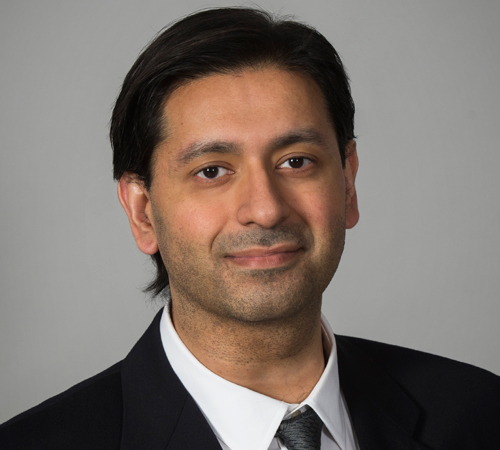
Dr. Khalid Syed, orthopaedic surgeon (Photo:UHN)
As an infant in the 1950's, Mr. Kavanagh was infected with paralytic polio. He suffered permanent paralysis in the lower part of his left leg, which prevented it from grow properly. Throughout his childhood, Mr. Kavanagh experienced many painful and experimental procedures to even out his legs. After leg braces, surgeries, even a full body cast, Mr. Kavanagh has had to learn how to walk three times over the course of his life. After becoming a patient of Dr. Khalid Syed, an orthopaedic surgeon at Toronto Western Hospital, Mr. Kavanagh's life-long dream of learning how to walk on legs that are the same length, in a body that can stand straight has be realized. Here are Dr. Syed's thoughts on being part of his patient's memoir.
UHN News:
What was your reaction when you found out you were included in Mr. Kavanagh's memoir?
Dr. Syed:
I was honoured to say the least. I was certainly intrigued. "The man who learned to walk three times" is a very well written and easy to read narrative. I read the book in one evening. I was shocked at how much this man had been through and very pleased that I had been able to help him achieve his life-long dream of walking independently.
I think that the greatest revelation was how the story describes the patient's perspective of going through the health-care system. It gives us, as health-care workers, an outside-in view of what we do and how it impacts on our patients. I take pride in knowing Mr. Kavanagh, because of his strength and courage and how he endured immense hardship and never gave up.
UHN News:
Mr. Kavanagh describes you as "a remarkably polite individual, an old-school gentleman", "he apologized for the long wait and exudes the sense that he is there for the two of us and that he has all day."
What is your approach/philosophy towards interacting with patients?
Dr. Syed:
Those are indeed kind words. My approach to patients is the same as most physicians. The patient is my focus and center of attention. I realize that patients often wait to see me and a few words of apology often let them know that I appreciate their patience. Then I turn my full and undivided attention towards the patient.
I carefully listen to what they have to say, examine them as required and I try to use simple everyday language to explain to them my analysis of their problem and the proposed solution. I educate the patients about the choices they have and let them make the final decision. I involve the patient fully in the decision making.
Respecting the patient's need to express themselves, their need for education and expert opinion and finally their autonomy in taking charge of their own health gives patients control over their condition. I find that patients appreciate this and are energized to follow through on whatever is required of them as part of their care.
UHN News:
You were able to help restore Mr. Kavanagh's ability to walk and even more, correct the length of his leg, something that has caused him difficultly for almost 60 years of his life. What is it like to have such a life changing impact on someone's life?
Dr. Syed:
It is both gratifying and humbling. I do what I do because I want to help patients and improve their quality of life. Those who know me will tell you that I am tireless in this effort. Patients are always thankful for the help we provide to them. We impact many people's lives every day.
The difference in Mr. Kavanagh's case is that he is a masterful orator who has actually qualified how much of a difference I as his surgeon and we as a hospital have made in his life. And it is just an incredible feeling and hugely satisfying. He has thanked all of us by writing his memoir and describing his wonderful experience with us in the immortal written word.
UHN News:
Mr. Kavanagh writes about the lengthening of his leg, nerves rebuilding themselves, the brain trying to interpret these new signals – the procedure you performed sounds amazing. What can be done now in the area of orthopaedics that couldn't be done say 10 or 20 years ago?
Dr. Syed:
Orthopedics has come a long way in a very short time. Huge advances in implant technology, bone fixation techniques and minimally invasive procedures have pushed us forward leaps and bounds. However, we have a blue ocean of possibilities ahead of us.
Advances in nerve regeneration, nano-technology for fracture repair and use of computer technology to improve personalized patient care are just some of the venues that will lead to astonishing advances in the near future.
What is near and dear to my heart, and to all of my colleagues in the arthritis program, is the potential of stem cell research to revolutionize the care of patients suffering from chronic debilitating conditions such as arthritis. Imagine having an injection and regenerating cartilage in your joints without surgery. It may sound like science fiction but so was manned flight, space travel and everything Apple. The deep blue ocean is vast and endless.
Listen to former CBC journalist Peter Kavanagh talk about his experience. (Video: Operation Maple YouTube)
